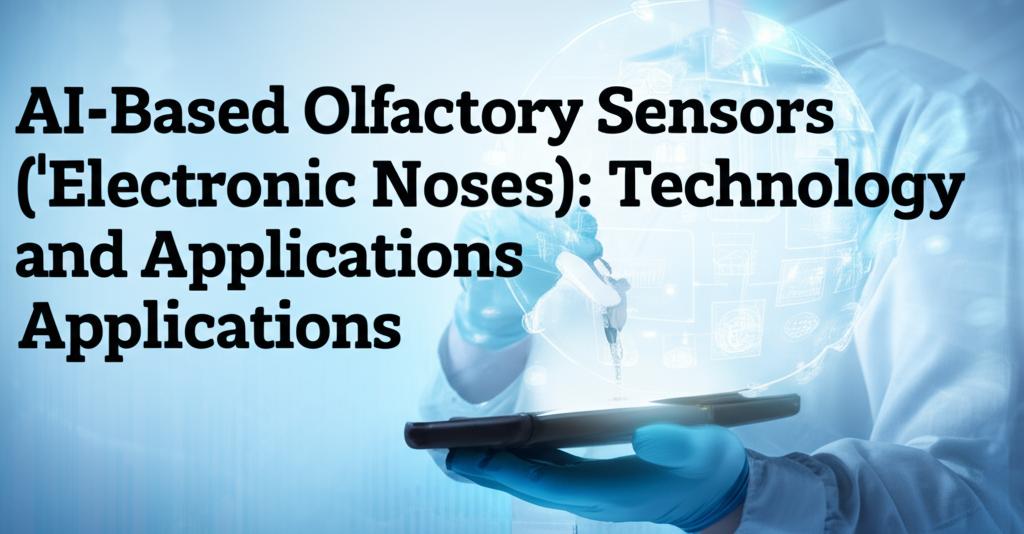AI-powered electronic noses, or e-noses, represent a significant leap in sensor technology, mimicking the human olfactory system to detect, analyze, and interpret complex odors and volatile organic compounds (VOCs). These sophisticated systems integrate advanced gas sensor arrays with powerful artificial intelligence (AI) algorithms, primarily machine learning (ML) and deep learning (DL), to provide capabilities far beyond traditional chemical sensors.
How the Technology WorksAt the heart of an AI-based e-nose are arrays of specialized gas sensors. Common sensor types include metal-oxide semiconductors (MOX), conducting polymers, and Micro Electro Mechanical Systems (MEMS) sensors. When exposed to ambient air containing VOCs – gaseous molecules emitted from various sources like food, human breath, or industrial processes – each sensor in the array responds differently based on its unique sensitivity to specific chemical compounds. This differential response generates a complex pattern or "odor fingerprint" unique to the specific mixture of volatiles present.
The Crucial Role of Artificial IntelligenceThe 'AI' in AI-based olfactory sensors is pivotal. Raw sensor data is often complex and requires sophisticated analysis to be meaningful. Artificial intelligence, particularly machine learning techniques like artificial neural networks (ANNs), support vector machines (SVMs), and increasingly, deep learning models like convolutional neural networks (CNNs) and recurrent neural networks (RNNs), are trained on large datasets of known odor fingerprints. These algorithms learn to recognize subtle differences and complex patterns within the sensor data, allowing the system to identify, classify, or quantify odors with high accuracy, often exceeding human capabilities in consistency and sensitivity. AI enables the e-nose to automate analysis, interpret complex data, compensate for sensor drift, and continuously improve its performance through learning.
Key Applications Spanning Diverse FieldsThe ability to accurately detect and interpret smells digitally has opened up a wide range of applications:
- Medical Diagnostics: This is a rapidly growing area. E-noses can analyze VOCs in exhaled breath, urine, sweat, or skin emissions, which often contain biomarkers indicative of diseases. They show promise for non-invasive, rapid, and cost-effective early detection and monitoring of conditions like various cancers, diabetes, metabolic disorders, respiratory diseases (like COPD and pneumonia), and infectious diseases (including tuberculosis and urinary tract infections). Integration with telehealth platforms is also emerging, allowing remote patient monitoring.
- Food Quality and Safety: E-noses are extensively used in the food and beverage industry. They assess food freshness (meat, fish, dairy, produce), detect spoilage or contamination, verify authenticity (e.g., wine origin, coffee blends, olive oil), profile aromas, monitor fermentation processes, and identify adulteration. This helps ensure product quality, extend shelf-life assessments, and reduce food waste. Some systems use color-changing barcodes read by AI-powered smartphone apps to indicate freshness.
- Environmental Monitoring: E-noses can detect pollutants, toxic gases, and monitor air and water quality in real-time. They are valuable tools for assessing environmental odors and ensuring compliance with regulations.
- Industrial and Safety Applications: In industrial settings, AI-powered e-noses monitor for hazardous gas leaks, control process emissions, and can even contribute to predictive maintenance by detecting chemical changes associated with machinery issues, such as lubricant breakdown. They are also being explored for enhancing robotic perception, giving machines a sense of smell for safer and more autonomous operation in complex or hazardous environments.
- Other Areas: Applications also extend to security and defense (detecting explosives or illicit substances), agriculture (monitoring crop ripeness or disease), cosmetics and perfumery (quality control and development), and even smart home systems.
The field is continuously evolving. Key advancements include the development of highly miniaturized sensors using MEMS technology, leading to more portable and potentially lower-cost devices. Sensor sensitivity and selectivity are improving, driven by new materials and nanotechnology. AI algorithms are becoming more sophisticated, particularly deep learning, significantly boosting accuracy and the ability to handle complex odor mixtures. Integration with smartphones, cloud computing, and the Internet of Things (IoT) is making the technology more accessible and enabling real-time data analysis and sharing.
While challenges related to standardization, sensor drift compensation, cost, and regulatory validation (especially in medical fields) remain, the trajectory is clear. AI-based electronic noses are poised to become increasingly integrated into various aspects of industry, healthcare, and daily life, offering powerful new ways to interact with and understand the chemical world through the sense of smell.

